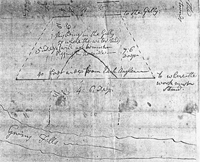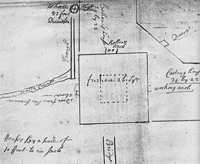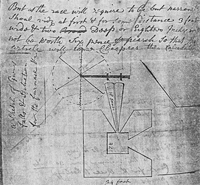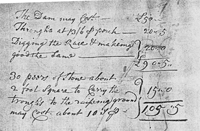
The System of a Blast Furnace
Blast furnaces seem alien, strange, and dangerous to us today.
But in fact, they are a remarkably simple technology — albeit on
a large scale — that is really no more mysterious than a fireplace
or pottery kiln. They take iron ore, charcoal (or later, coal), and
limestone to turn out iron for use by the community or for export
and sale beyond the community. In order to understand the blast furnace,
let's take a look at one built in Maryland in the 1760s. It was both
advanced for its time and also representative of the traditional
method of blast furnace construction. Looking at contemporary
plans can let us understand the elements and design considerations
that went into the structure. (Click on the images for a full-screen
image.)
 When determining where to put a furnace, the iron master needed a
source of flowing water. Here you can see that the iron
master has chosen to place it next to a stream he labeled "Guiny Falls."
The falls gave the potential energy,
or "head," of the water to drive the bellows that provide
the blast.
When determining where to put a furnace, the iron master needed a
source of flowing water. Here you can see that the iron
master has chosen to place it next to a stream he labeled "Guiny Falls."
The falls gave the potential energy,
or "head," of the water to drive the bellows that provide
the blast.
On the furnace stack itself, he writes, "This being in the gully
where the water stands 5' deep will not be much digging
in the middle." In this he is referring to the typical need
-- not needed here -- to excavate a great deal of earth
to build the foundations of the furnace. Interestingly,
although it is imperative to keep water from under a
blast furnace's base, here he seems fine with building
it in an obviously damp place. Either way, you can see
at the bottom he notes it will be a 40'-wide furnace
stack.
 In designing the wheel, the iron master (or the millwright) wrote "Allowing
8 inches distance to [each] buckets [picture] an inch each.
[I] think the Circumference 72 foot will take 96 [buckets]."
"The slope of the above Buckets is 8 inches from the perpendicular
at ye extreme part in ye Extreme part in the clere & 7½
at ye double[?] 7½"
You can see therefore that the layout went from bucket to wheel, rather
than the other way around.
In designing the wheel, the iron master (or the millwright) wrote "Allowing
8 inches distance to [each] buckets [picture] an inch each.
[I] think the Circumference 72 foot will take 96 [buckets]."
"The slope of the above Buckets is 8 inches from the perpendicular
at ye extreme part in ye Extreme part in the clere & 7½
at ye double[?] 7½"
You can see therefore that the layout went from bucket to wheel, rather
than the other way around.
When the millwright needed to build a waterwheel to run the bellows,
he needed to channel water over it. If it was to be about
23 feet tall, he needed to dam the river upstream where there
was at least 23 feet of drop from the top of the dam to the
mill and furnace.
On this drawing, he has noted at no. 1 near the top, "the rock where
the dam is to be" by Guiny falls, as well as a small
side stream that enters the main river just below it.
The water to the mill (or 'mill race' as it was called)
therefore had to be piped or channeled over the side stream before
it could run in a race cut into the ground.
You can also see a small secondary dam that runs a race to the building
numbered 3 which is labeled simply "The Mill" (presumably
a grist mill) and the diagonal line on the right runs
just a bit further to the furnace (off the map in this
view.
Overall, the raceway to the furnace is noted as being 30 perches long
in the trough over the side stream and 130 perches long
to the furnace itself. A perch is an old-time unit of
length measurement. Find out how long it was and then
calculate the distances involved. Approximately what sort of acreage, therefore, does this mill and furnace complex cover?
 This site plan shows the main square furnace in the middle, and the
22' diameter wheel drawn schematically at the top left.
The L-shaped lines extending up and to the right from the furnace are
the outlines of the wooden buildings typically built against
the furnace stack.
This site plan shows the main square furnace in the middle, and the
22' diameter wheel drawn schematically at the top left.
The L-shaped lines extending up and to the right from the furnace are
the outlines of the wooden buildings typically built against
the furnace stack.
The top area is labeled "Bellows house"
where the wood and leather bellows that were run by the
waterwheel (like at Saugus)
would be kept inside out of the elements and blew air
into the "Bellows arch". To the right is the "Casting
house" where the molten metal would be tapped out of
the "working arch" onto a sand floor and molded into
useful objects of just small ingots known as "pigs."
 In this closeup of the furnace, bellows and waterwheel, you can see
the dark shaft coming off the waterwheel (here drawn
flattened on its side) and the two projections on the
shaft (called 'cams') that drive the bellows. Typically
a bellows would be driving on the upstroke and then some
heavy counterweights would compress them, forcing air into the furnace at
an even rate. The two bellows would operate out of sync, so that
a more or less steady rate of air flow would be achieved.
In this closeup of the furnace, bellows and waterwheel, you can see
the dark shaft coming off the waterwheel (here drawn
flattened on its side) and the two projections on the
shaft (called 'cams') that drive the bellows. Typically
a bellows would be driving on the upstroke and then some
heavy counterweights would compress them, forcing air into the furnace at
an even rate. The two bellows would operate out of sync, so that
a more or less steady rate of air flow would be achieved.
You can also see the footprint of the furnace, with the two large indents
for the bellows and working arches so that the workers
(and bellows nozzle) can get into the relatively small
center area of the furnace itself. The sideways text
reads, "A sketch of Guiny falls & Pertinations for
the furnace &c."
The caption above relates to the cost of the race in the next picture
and reads, "But
as the race will require to be but narrow shoal vidz.
at first and for some distance 3 foot wide & 2 deep or
eighteen inches [it] will not be worth six pence per pearch so that article
will come cheaper than Calder."
 In this summation of the costs involved, the millwright has broken
it down into categories:
In this summation of the costs involved, the millwright has broken
it down into categories:
Remember that they are still pricing in pounds and shilling here. Find
out how much £100 in 1765 is in today's dollars. Notice that he is
being rough in his calculations.
Return to:
One-Minute Essays
 |
|

|